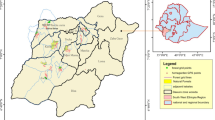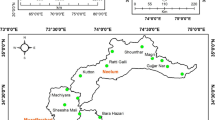Abstract
Indigenous medicine is important to rural livelihoods, but lay knowledge and use of medicinal plants has not been extensively studied. Research in KwaZulu-Natal, South Africa, showed that medicinal plants were frequently used by villagers and contributed to their ability to cope with health problems. Knowledge of plants and household remedies was extensive and varied in that households often held different knowledge. Villagers mainly relied on common species, and were generally aware of alternative species for a certain ailment. People were flexible in their use of indigenous and western health care, which were both perceived as beneficial. Improved cooperation between health care systems could improve health standards. Extraction of medicinal plants has been described as unsustainable in the region—a situation not found in the study area. It is argued that conservation policies aimed to restrict access should be differential and potentially not include local consumption, since this may be ecologically unnecessary and entail local hardships.



Similar content being viewed by others
References
Andrén, H. (2001). Wetland resources in the rainbow nation—a pot of gold or a lot of problems? Masters thesis, Department of Human Geography, Stockholm University.
Bhat, R. B., and Jacobs, T. V. (1995). Traditional Herbal Medicine in Transkei. Journal of Ethnopharmacology 48: 7–12.
Berkes, F., and Turner, N. J. (2006). Knowledge, Learning and the Evolution of Conservation Practice for Socio-Ecological System Resilience. Human Ecology 34(4): 479–494.
Botha, J., Witkowski, E. D. T. F., and Shackleton, C. M. (2007). Factors Influencing Prices of Medicinal Plants Traded in the Lowveld, South Africa. International Journal of Sustainable Development and World Ecology 14(5): 450–469.
Brown, K. (1995). Medicinal plants, indigenous medicine and conservation of biodiversity in Ghana. In Swanson, T. (ed.), Intellectual Property Rights and Biodiversity Conservation. an Interdisciplinary Analysis of the Values of Medicinal Plants. Cambridge University Press, Cambridge, pp. 201–231.
Bryant, A. T. (1929). Olden Times in Zululand and Natal: Containing Earlier Political History of the Eastern-Nguni Clans. Longmans, Green & Co., London.
Campbell, B. M. S., and Luckert, M. K. (eds.) (2002). Uncovering the Hidden Harvest: Valuation Methods for Woodland and Forest Resources. Earthscan, London.
Cocks, M., and Dold, A. (2000). The Role of ‘African Chemists’ in the Health Care System of the Eastern Cape Province of South Africa. Social Science & Medicine 51: 1505–1515.
Cocks, M., and Møller, V. (2002). Use of Indigenous and Indigenised Medicines to Enhance Personal Well-Being: A South African Case Study. Social Science and Medicine 54: 387–397.
Cunningham, A. (1988a). Over-Exploitation of Medicinal Plants in Natal/Kwazulu: Root Causes. Veld & Flora 74: 85–87.
Cunningham, A. (1988b). An investigation of the herbal medicine trade in Natal/KwaZulu. Investigational Report No 29. Institute of Natural Resources, University of Natal, Pietermaritzburg.
Cunningham, A. (1989). Herbal Medicine Trade. A Hidden Economy. Indicator SA 6: 51–54.
Cunningham, A. (1991). The herbal medicine trade: resource depletion and environmental management for a “hidden economy”. In Preston-Whyte, E., and Rogerson, C. (eds.), South Africa’s Informal Economy. Oxford University Press, Cape Town, pp. 196–206.
Cunningham, A. B. (2001). Applied Ethnobotany. People, Wild Plant Use and Conservation. Earthscan Publications, London.
Dahlberg, A. C. (2005). Local Resource Use, Nature Conservation and Tourism in Mkuze Wetlands, South Africa: A Complex Weave of Dependence and Conflict. Danish Journal of Geography 105(1): 43–55.
Dahlberg, A. C., and Blaikie, P. M. (1999). Changes in Landscape or in Interpretation? Reflections Based on the Environmental and Socioeconomic History of a Village in NE Botswana. Environment and History 5(2): 127–174.
Dahlberg, A. C., Ellery, W., Garland, G., Neal, M., Barnes, K., Koaleli, M., and Schoultz, A. (1999). Multidisciplinary Environmental Research Done in the Mkuze Wetland, Maputaland. South African Wetlands 10: 20–22.
Dauskardt, R. (1991). ‘Urban herbalism’: the restructuring of informal survival in Johannesburg. In Preston-Whyte, E., and Rogerson, C. (eds.), South Africa’s Informal Economy. Oxford University Press, Cape Town.
Diederichs, N. (2001). Dictionary of Popularly Traded Plants in South Africa. Institute of Natural Resources, Scottsville.
Dold, A. P., and Cocks, M. L. (2000). The Medicinal Use of Some Weeds, Problem and Alien Plants in the Grahamstown and Peddie Districts of the Eastern Cape, South Africa. South African Journal of Science 96: 467–473.
Dovie, D. B. K., Shackleton, C. M., and Witkowski, E. T. F. (2002). Direct-Use Values of Woodland Resources Consumed and Traded in a South African Village. International Journal of Sustainable Development and World Ecology 9: 269–283.
El Ansari, W., Philips, C. J., and Zwi, A. B. (2002). Narrowing the Gap Between Academic Professional Wisdom and Community Lay Knowledge: Perceptions from Partnerships. Public Health 116: 151–159.
Ellery, W. N., Dahlberg, A. C., Strydom, R., Neal, M. J., and Jackson, J. (2003). Diversion of Water Flow from a Floodplain Wetland Stream: An Analysis of Geomorphological Setting and Hydrological and Ecological Consequences. Journal of Environmental Management 68: 51–71.
Grenier, L. (1998). Working with Indigenous Knowledge. International Development Research Centre, Ottawa.
Grierson, D. S., and Afolayan, A. J. (1999). An Ethnobotanical Study of Plants Used for the Treatment of Wounds in the Eastern Cape, South Africa. Journal of Ethnopharmacology 67: 327–332.
Hutchings, A. (1989). Observations on Plant Usage in Xhosa and Zulu Medicine. Bothalia 19(2): 225–235.
Hutchings, A., Scott, A. H., Lewis, G., and Cunningham, A. B. (1996). Zulu Medicinal Plants. An Inventory. University of Natal Press, Pietermaritzburg.
Joubert, P. H., Sebata, P. D. B., and van Reenen, O. R. (1984). Self-Medication in a Developing Community. South African Medical Journal 65: 129–131.
Koziell, I., and Saunders, J., (eds.) (2001). Living of Biodiversity: Exploring Livelihoods and Biodiversity. IIED, London.
Mander, M. (1998). Marketing of indigenous medicinal plants in South Africa. A case study in KwaZulu-Natal. Report, FAO.
Marshall, N. T. (1998). Searching for a Cure: Conservation of Medicinal Wildlife Resources in East and Southern Africa. TRAFFIC International, Cambridge, UK.
Matsiliza, B., and Barker, N. P. (2001). A Preliminary Survey of Plants Used in Traditional Medicine in the Grahamstown Area. South African Journal of Botany 67: 177–182.
McIntosh, I. (2002). Defining Oneself, and Being Defined as, Indigenous. Anthropology Today 18(3): 23–25.
McNeely, J. (1992). Nature and Culture: Conservation Needs Them Both. Nature & Resources 28: 37–43.
Neumann, R. P. (2005). Making Political Ecology. Hodder Education, London.
Ngubane, H. (1977). Body and Mind in Zulu Medicine. Academic, London.
Ngwane, A., and Hirschowitz, R. (1998). Living in KwaZulu-Natal. Selected findings of the 1995 October household report. Publication, Central Statistics, Pretoria.
Pooley, E. (1997). The Complete Field Guide to Trees of Natal, Zululand & Transkei. Natal Flora Publications Trust, Durban.
Pooley, E. (1998). A Field Guide to Wild Flowers. KawZulu-Natal and the Eastern Region. Natal Flora Publications Trust, Durban.
Rothwell, A. F. (1998). The role of indigenous knowledge in sustainable development—a case study of medicinal plant use in the upper Tugela valley. Masters thesis, Department of Geographical and Environmental Sciences, University of Natal, Durban.
Shackleton, C. M., and Shackleton, S. E. (2004). Use of woodland resources for direct householc provisioning. In Lawes, M. J., Eeley, H. A. C., Shackleton, C. M., and Geach, B. G. S. (eds.), Indigenous Forests and Woodlands in South Africa. Policy, People and Practice. University of KwaZulu-Natal Press, Scottsville, pp. 195–225.
Shackleton, S. E., Shackleton, C. M., Netshiluvhi, T. R., Geach, B. S., Ballance, A., and Fairbanks, D. H. K. (2002). Use Patterns and Value of Savanna Resources in Three Rural Villages in South Africa. Economic Botany 56(2): 130–146.
Sillitoe, P., and Bicker, A. (2004). Introduction. Hunting for theory, gathering ideology. In Bicker, A., Sillitoe, P., and Pottier, J. (eds.), Development and Local Knowledge. New Approaches to Issues in Natural Resource Management, Conservation and Agriculture. Routledge, London, pp. 1–18.
South Africa HIV & AIDS Statistics (2007). Online http://www.avert.org/safricastats.htm.
Srivastava, J., Lambert, J., and Vietmeyer, N. (1996). Medicinal plants. An expanding role in development. World Bank Technical Paper No 320, Washington.
Statistics South Africa (1996). Census data for 1996. Government of South Africa. Online: http://www.statssa.gov.za/ (Publication date: 1 June 1998).
Statistics South Africa (2001). Census data for 2001. Government of South Africa. Online: http://www.statssa.gov.za/ (Publication date:2 June 2003).
Taylor, J. L. S., Rabe, T., McGaw, L. J., Jäger, A. K., and van Staden, J. (2001). Towards the Scientific Validation of Traditional Medicinal Plants. Plant Growth Regulation 34: 23–37.
Trygger, S. (2003). Local extraction and use of medicinal plants. A case study from Mkuze Wetlands, South Africa. SLU Communications, Minor Field Studies No 257, Swedish University of Agricultural Sciences, Uppsala.
Twine, W., Moshe, D., Netshiluvhi, T., and Siphugu, V. (2003). Consumption and Direct-Use Values of Savanna Bio-Resources Used by Rural Households in Mametja, a Semi-Arid Area of Limpopo Province, South Africa. South African Journal of Science 99: 467–473.
Tyiso, S., and Bhat, R. B. (1998). Medicinal Plants Used for Child Welfare in the Transkei Region Of the Eastern Cape (South Africa). Journal of Applied Botany 72: 92–98.
van Wyk, B.-E., and Gericke, N. (2000). People’s Plants. A Guide to Useful Plants of Southern Africa. Briza, Pretoria.
WHO (2002). Traditional Medicine Strategy 2002–2005, World Health Organization, WHO/EDM/TRM/2002.1, Geneva, p 7.
Acknowledgements
The research was made possible through funding by the Swedish Agency for International Development Cooperation/The Department for Research Cooperation (Sida/SAREC), the Swedish Research Council, SSAG, and Geografiska Förbundet. We wish to thank the people of Mnqobokazi who welcomed us, and who generously shared their time and knowledge with us. We are especially grateful to Samuel Ngwane, who sadly passed away in June 2008. We want to thank Pilisiwe Nhlenyama, Fish Nhlenyama and Shinga Mthethwa for their help and enthusiasm. We are also indebted to Wille Östberg, Charlie Shackleton and two anonymous reviewers for insightful comments on earlier versions of the paper. The interpretation of facts and views expressed in this paper are those of the authors alone.
Author information
Authors and Affiliations
Corresponding author
Rights and permissions
About this article
Cite this article
Dahlberg, A.C., Trygger, S.B. Indigenous Medicine and Primary Health Care: The Importance of Lay Knowledge and Use of Medicinal Plants in Rural South Africa. Hum Ecol 37, 79–94 (2009). https://doi.org/10.1007/s10745-009-9217-6
Published:
Issue Date:
DOI: https://doi.org/10.1007/s10745-009-9217-6




